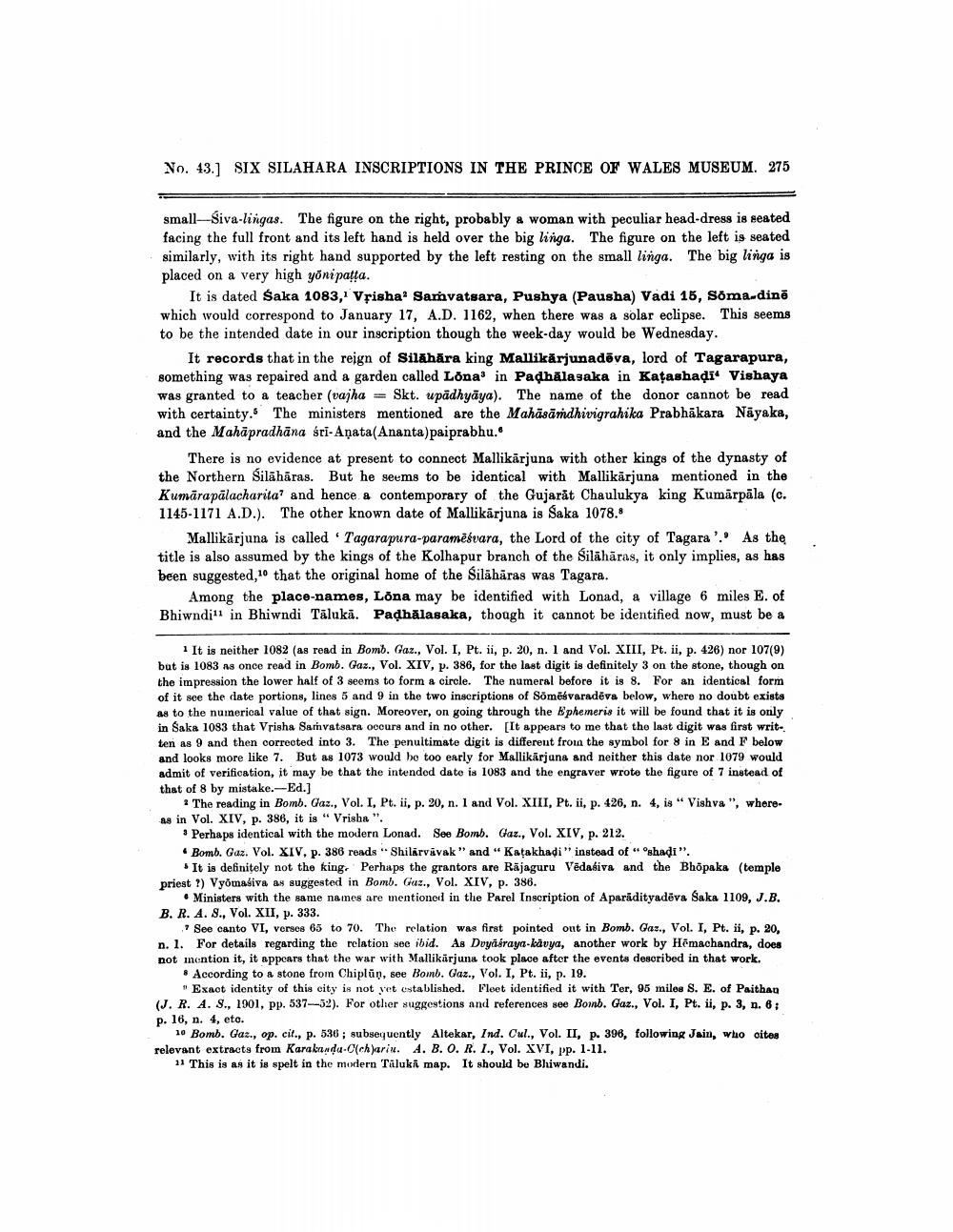________________
No. 43.] SIX SILAHARA INSCRIPTIONS IN THE PRINCE OF WALES MUSEUM. 275
small-Siva-lingas. The figure on the right, probably a woman with peculiar head-dress is seated facing the full front and its left hand is held over the big linga. The figure on the left is seated similarly, with its right hand supported by the left resting on the small linga. The big linga is placed on a very high yonipatta.
It is dated saka 1083, Vrisha Samvatsara, Pushya (Pausha) Vadi 15, Soma-dino which would correspond to January 17, A.D. 1162, when there was a solar eclipse. This seems to be the intended date in our inscription though the week-day would be Wednesday.
It records that in the reign of Silāhāra king Mallikarjunadēva, lord of Tagarapura, something was repaired and a garden called Lona in Padhālasaka in KațashadiVishaya was granted to a teacher (vajha = Skt. upādhyāya). The name of the donor cannot be read with certainty. The ministers mentioned are the Mahāsāṁdhivigrahika Prabhākara Nāyaka, and the Mahāpradhana sri-Anata(Ananta)paiprabhu.
There is no evidence at present to connect Mallikarjuna with other kings of the dynasty of the Northern Silāhāras. But he seems to be identical with Mallikārjuna mentioned in the Kumāra pālacharita? and hence a contemporary of the Gujarāt Chaulukya king Kumārpāla (c. 1145-1171 A.D.). The other known date of Mallikarjuna is Saka 1078.
Mallikārjuna is called Tagarapura-paramēsvara, the Lord of the city of Tagara'. As the title is also assumed by the kings of the Kolhapur branch of the Silāhāras, it only implies, as has been suggested to that the original home of the Silahāras was Tagara.
Among the place-names, Lona may be identified with Lonad, a village 6 miles E. of Bhiwnditi in Bhiwndi Talukā. Padhālasaka, though it cannot be identified now, must be a
It is neither 1082 (as read in Bomb. Gaz., Vol. I, Pt. ii, p. 20, n. 1 and Vol. XIII, Pt. ii, p. 426) nor 107(9) but is 1083 As once read in Bomb. Gaz., Vol. XIV, p. 386, for the last digit is definitely 3 on the stone, though on the impression the lower half of 3 seems to form a circle. The numeral before it is 8. For an identical form of it see the date portions, lines 5 and 9 in the two inscriptions of Sõmēsvaradēvs below, where no doubt exists as to the numerical value of that sign. Moreover, on going through the Ephemeris it will be found that it is only in Saka 1083 that Vrisha Samvatsara occurs and in no other. [It appears to me that the last digit was first written as 9 and then corrected into 3. The penultimate digit is different from the symbol for 8 in E and F below and looks more like 7. But as 1073 would be too early for Mallikarjuna and neither this date nor 1079 would admit of verification, it may be that the intended date is 1083 and the engraver wrote the figure of 7 instead of that of 8 by mistake.-Ed.]
The reading in Bomb. Gaz., Vol. I, Pt. ii, p. 20, n. 1 and Vol. XIII, Pt. ii, p. 426, n. 4, is" Vishva", whereas in Vol. XIV, p. 386, it is " Vrisha ".
Perhaps identical with the modern Lonad. See Bomb. Gaz., Vol. XIV, p. 212. • Bomb. Gaz. Vol. XIV, p. 386 reads "Shilárvavak" and " Katakhadi" instead of " oshadi".
It is definitely not the king. Perhaps the grantors are Rājaguru Vēdasiva and the Bhopaka (temple priest ?) Vyömasiva as suggested in Bomb. Gus., Vol. XIV, p. 386.
• Ministers with the same names are mentioned in the Parel Inscription of Aparādityadēva Saka 1109, J.B. B. R. A. S., Vol. XII, p. 333.
See canto VI, verses 65 to 70. The relation was first pointed out in Bomb. Gas., Vol. I, Pt. ii, p. 20, n. l. For details regarding the relation sec ibid. As Dvyasraya-kavya, another work by Hēmachandra, does not incntion it, it appears that the war with Mallikarjuna took place after the events described in that work.
According to a stone from Chiplūņ, see Bomb. Gaz., Vol. I, Pt. ii, p. 19.
"Exact identity of this city is not yet established. Fleet identified it with Ter, 95 miles S. E. of Paithan (J. R. A. S., 1901, pp. 537-52). For other suggestions and references see Bomb. Gaz., Vol. I, Pt. ii, p. 3, n. 6; p. 16, n. 4, etc.
10 Bomb. Gaz., op. cit., p. 536; subsequently Altekar, Ind. Cul., Vol. II, p. 396, following Jsin, who oites relevant extracts from Karakanda-C(ch)ariu. A. B. O. R. I., Vol. XVI, pp. 1-11.
11 This is as it is spelt in the modern Taluki map. It should be Bhiwandi.




